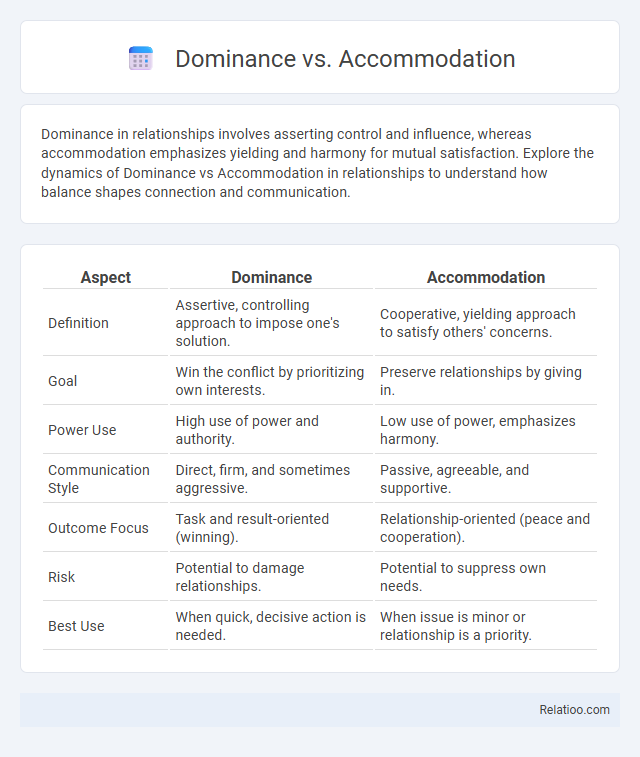Dominance in relationships involves asserting control and influence, whereas accommodation emphasizes yielding and harmony for mutual satisfaction. Explore the dynamics of Dominance vs Accommodation in relationships to understand how balance shapes connection and communication.
Table of Comparison
| Aspect | Dominance | Accommodation |
|---|---|---|
| Definition | Assertive, controlling approach to impose one's solution. | Cooperative, yielding approach to satisfy others' concerns. |
| Goal | Win the conflict by prioritizing own interests. | Preserve relationships by giving in. |
| Power Use | High use of power and authority. | Low use of power, emphasizes harmony. |
| Communication Style | Direct, firm, and sometimes aggressive. | Passive, agreeable, and supportive. |
| Outcome Focus | Task and result-oriented (winning). | Relationship-oriented (peace and cooperation). |
| Risk | Potential to damage relationships. | Potential to suppress own needs. |
| Best Use | When quick, decisive action is needed. | When issue is minor or relationship is a priority. |
Understanding Dominance vs Accommodation
Understanding dominance vs accommodation involves analyzing how individuals assert control or yield in social interactions. Dominance reflects behaviors aimed at maintaining or enhancing power, often through assertiveness and influence. Accommodation involves adapting communication or behavior to align with others, fostering harmony and reducing conflict in relationships.
Definitions and Core Concepts
Dominance refers to asserting control or influence over others in a social or professional setting, emphasizing power and authority to achieve desired outcomes. Accommodation involves adjusting your behavior or opinions to align with others, prioritizing harmony and relationship maintenance over personal preferences. Understanding these core concepts helps you navigate interactions by balancing assertiveness with cooperation to optimize communication and conflict resolution.
Psychological Roots of Dominance
Dominance originates from psychological needs for control, status, and security, often rooted in early childhood experiences and social environment. Accommodation reflects a tendency to prioritize relationships and social harmony over individual assertion, driven by empathy and conflict avoidance mechanisms. Your understanding of dominance dynamics is crucial for navigating social hierarchies and balancing power with cooperation.
The Nature of Accommodation in Human Interaction
Accommodation in human interaction involves adjusting your communication style to align with others, promoting understanding and reducing conflict. This adaptive behavior contrasts with dominance, which emphasizes control and assertiveness in conversations. Recognizing the nature of accommodation helps you foster cooperation and build stronger social bonds through empathy and flexibility.
Dominance in Leadership and Authority
Dominance in leadership emphasizes assertive control and decision-making power to influence group behavior and achieve organizational goals. Your ability to display dominance effectively establishes authority, sets clear expectations, and directs team dynamics to enhance productivity. Accommodation, by contrast, involves yielding to others' preferences to maintain harmony, often balancing dominance to foster collaboration without undermining leadership strength.
Accommodation in Conflict Resolution
Accommodation in conflict resolution emphasizes yielding or smoothing over differences to maintain harmony, often prioritizing relationships above individual goals. This approach contrasts sharply with dominance, where one party asserts control to win the conflict, and compromise, which seeks a middle ground satisfying both parties partially. Understanding when to use accommodation can help you preserve long-term connections and reduce tensions in emotionally charged disputes.
Cultural Influences on Dominance and Accommodation
Cultural influences significantly shape dominance and accommodation behaviors in communication, where dominant cultures often assert control through direct language and decision-making styles, while accommodative cultures prioritize harmony and adapt their speech to maintain social cohesion. Your ability to navigate these cultural dynamics impacts conflict resolution and collaborative efforts, as individuals from high-power distance cultures may prefer dominance strategies, whereas those from collectivist cultures lean toward accommodation to preserve relationships. Understanding these nuanced cultural frameworks enhances effective cross-cultural communication and minimizes misunderstandings.
Advantages and Disadvantages of Each Approach
Dominance in conflict resolution offers clear authority and quick decision-making but risks suppressing others' input, causing resentment and reduced collaboration. Accommodation prioritizes harmony and relationships by yielding to others' preferences, yet it may lead to unmet needs and perceived weakness over time. Balancing dominance and accommodation allows you to assert control when necessary while maintaining positive interpersonal dynamics, promoting effective and adaptable conflict management.
Balancing Dominance and Accommodation for Success
Balancing dominance and accommodation is crucial for achieving effective leadership and collaboration within teams. Dominance drives decision-making and confidence, while accommodation fosters empathy and adaptability to others' needs. Striking the right balance enhances conflict resolution, improves communication, and promotes a productive work environment conducive to success.
Choosing the Right Strategy for Different Situations
Choosing the right strategy between dominance, accommodation, and compromise depends on the specific dynamics of your situation, including the importance of your goals and the relationship with others involved. Dominance asserts your position firmly when quick decision-making is essential, while accommodation prioritizes maintaining harmony by yielding to others' needs. Compromise strikes a balance by addressing both parties' interests, making it effective when mutual satisfaction is crucial for ongoing collaboration.

Infographic: Dominance vs Accommodation
 relatioo.com
relatioo.com